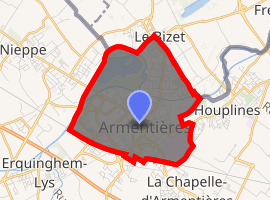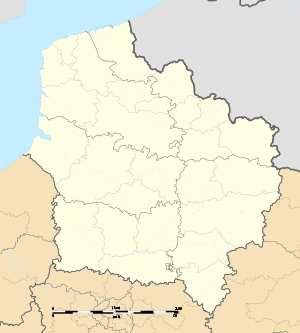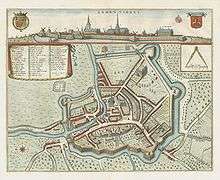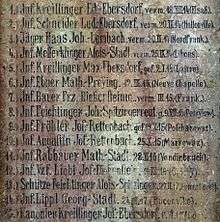Armentières
Armentières (IPA: [aʁmɑ̃tjɛʁ]; Dutch: Armentiers) is a commune in the Nord department in the Hauts-de-France region in northern France. It is part of the Urban Community of Lille Métropole.
Armentières | |
|---|---|
The town hall | |
.svg.png) Coat of arms | |
Location of Armentières 
| |
 Armentières  Armentières | |
| Coordinates: 50°41′17″N 2°52′52″E | |
| Country | France |
| Region | Hauts-de-France |
| Department | Nord |
| Arrondissement | Lille |
| Canton | Armentières |
| Intercommunality | Métropole Européenne de Lille |
| Government | |
| • Mayor (2014–2020) | Bernard Haesebroeck |
| Area 1 | 6.28 km2 (2.42 sq mi) |
| Population (2017-01-01)[1] | 24,882 |
| • Density | 4,000/km2 (10,000/sq mi) |
| Time zone | UTC+01:00 (CET) |
| • Summer (DST) | UTC+02:00 (CEST) |
| INSEE/Postal code | 59017 /59280 |
| 1 French Land Register data, which excludes lakes, ponds, glaciers > 1 km2 (0.386 sq mi or 247 acres) and river estuaries. | |
The motto of the town is Pauvre mais fière (Poor but proud).
Geography
Armentières lies on the Belgian border, northwest of the city of Lille, on the right bank of the river Lys.
History

In 1668, the town became French, along with most of the rest of French Flanders. At the end of the 19th century and the beginning of the 20th, Armentières acquired fame, being the “City of Fabric”. Industrial weaving, spinning and brewing grew in Armentières, benefitting from the presence of water.
Armentières particularly suffered during the World Wars although the town received two Military Crosses (one for World War I and the second for the Second World War) and the Legion d'Honneur. In Armentières and the surrounding areas, the military cemeteries are places of remembrance for the casualties of the World Wars. "Mademoiselle from Armentières" was a popular song among Allied soldiers in World War I.
During World War I, in October 1914, the town was the site of the Battle of Armentières. In April 1918, German troops shelled Armentières with mustard gas. British troops were forced to evacuate the area, but the Germans could not enter for two weeks because of the heavy contamination. Witnesses to the bombardment stated that the shelling was so heavy that liquid mustard ran in the streets.[2][3]
Population
| Population of Armentières since 1793 | ||
|---|---|---|
| Year | Pop. | ±% |
| 1793 | 7,671 | — |
| 1800 | 7,598 | −1.0% |
| 1806 | 7,542 | −0.7% |
| 1821 | 7,681 | +1.8% |
| 1831 | 6,338 | −17.5% |
| 1836 | 6,512 | +2.7% |
| 1841 | 6,817 | +4.7% |
| 1846 | 7,959 | +16.8% |
| 1851 | 8,840 | +11.1% |
| 1856 | 10,104 | +14.3% |
| 1861 | 11,901 | +17.8% |
| 1866 | 15,579 | +30.9% |
| 1872 | 19,035 | +22.2% |
| 1876 | 21,746 | +14.2% |
| 1881 | 25,089 | +15.4% |
| 1886 | 27,985 | +11.5% |
| 1891 | 28,638 | +2.3% |
| 1896 | 29,603 | +3.4% |
| 1901 | 29,401 | −0.7% |
| 1906 | 28,613 | −2.7% |
| 1911 | 28,625 | +0.0% |
| 1921 | 14,758 | −48.4% |
| 1926 | 21,035 | +42.5% |
| 1931 | 22,704 | +7.9% |
| 1936 | 24,049 | +5.9% |
| 1946 | 22,667 | −5.7% |
| 1954 | 24,940 | +10.0% |
| 1962 | 25,248 | +1.2% |
| 1968 | 26,916 | +6.6% |
| 1975 | 26,346 | −2.1% |
| 1982 | 24,834 | −5.7% |
| 1990 | 25,219 | +1.6% |
| 1999 | 25,249 | +0.1% |
| 2006 | 24,836 | −1.6% |
| 2009 | 25,089 | +1.0% |
| 2010 | 25,375 | +1.1% |
| 2011 | 25,704 | +1.3% |
| 2015 | 25,066 | −2.5% |
Heraldry
.svg.png) Arms of Armentières |
The arms of Armentières are blazoned : Argent a fleur de lys gules and on a chief of the same a sun or and a decrescent of the same. |
Railways
Armentières has a railway station on the line from Lille to Calais and Dunkirk.
International relations

Armentières is twinned with:
Notable people
- Dany Boon, French actor and stand-up comedian
- Jean Maurice Fiey, Church historian and Syriacist
- Amédée Fournier, French road bicycle racer and Olympic medallist
Monuments
.jpg)
The belfry of Armentière is a classified World heritage of UNESCO monument. The belfry, just like the nearing city hall was designed by the architect Louis Marie Cordonnier and is open for visitors and tourists.[4]
In fiction
Milady de Winter in The Three Musketeers hides in Armentières and is caught and executed there.
See also
References
- "Populations légales 2017". INSEE. Retrieved 6 January 2020.
- Heller, Charles E. (September 1984). "Chemical Warfare in World War I: The American Experience, 1917–1918". U.S. Army Command and General Staff College. Fort Leavenworth, Kansas. Archived from the original on July 4, 2007. Retrieved January 15, 2009.
- https://timesmachine.nytimes.com/timesmachine/1918/06/07/102707334.pdf
- "Destination lille Cities and territories". www.visitlilles.com. Retrieved 2019-11-19.
External links
| Wikimedia Commons has media related to Armentières. |
- Armentières official website (in French)
- The reconstruction of the town hall of Armentières after WW1 on the website "Remembrance Trails of the Great War in Northern France"
.svg.png)